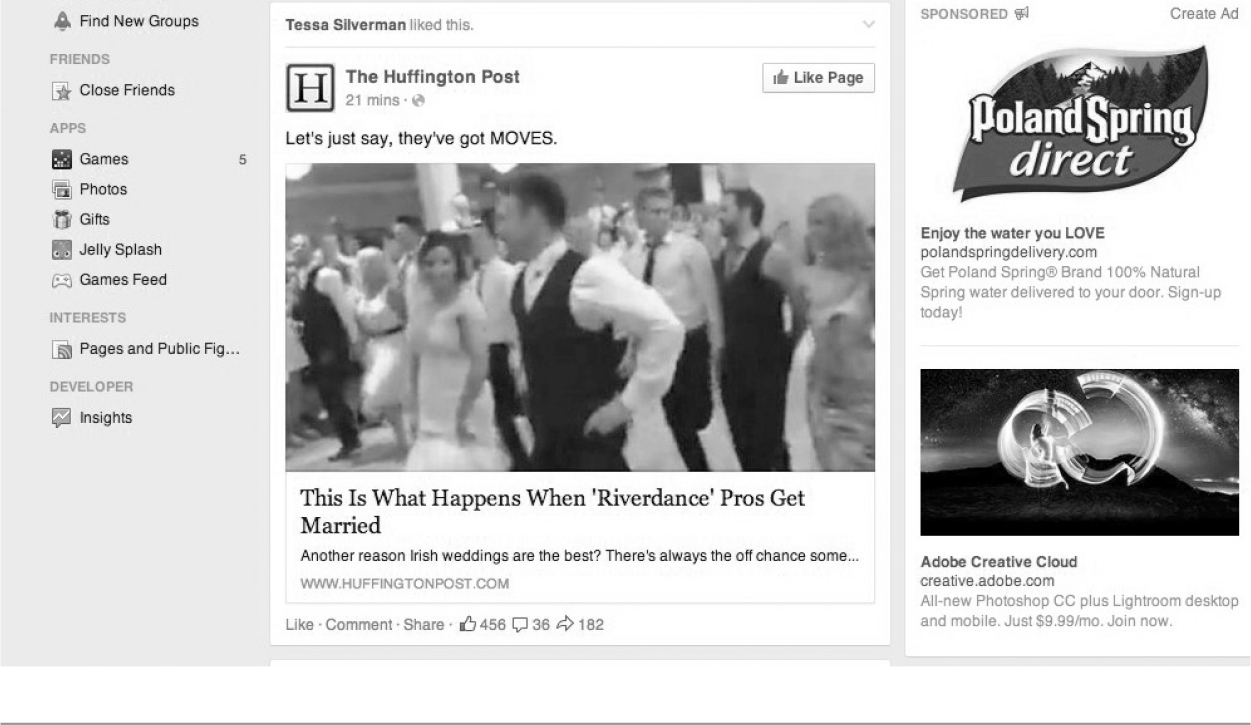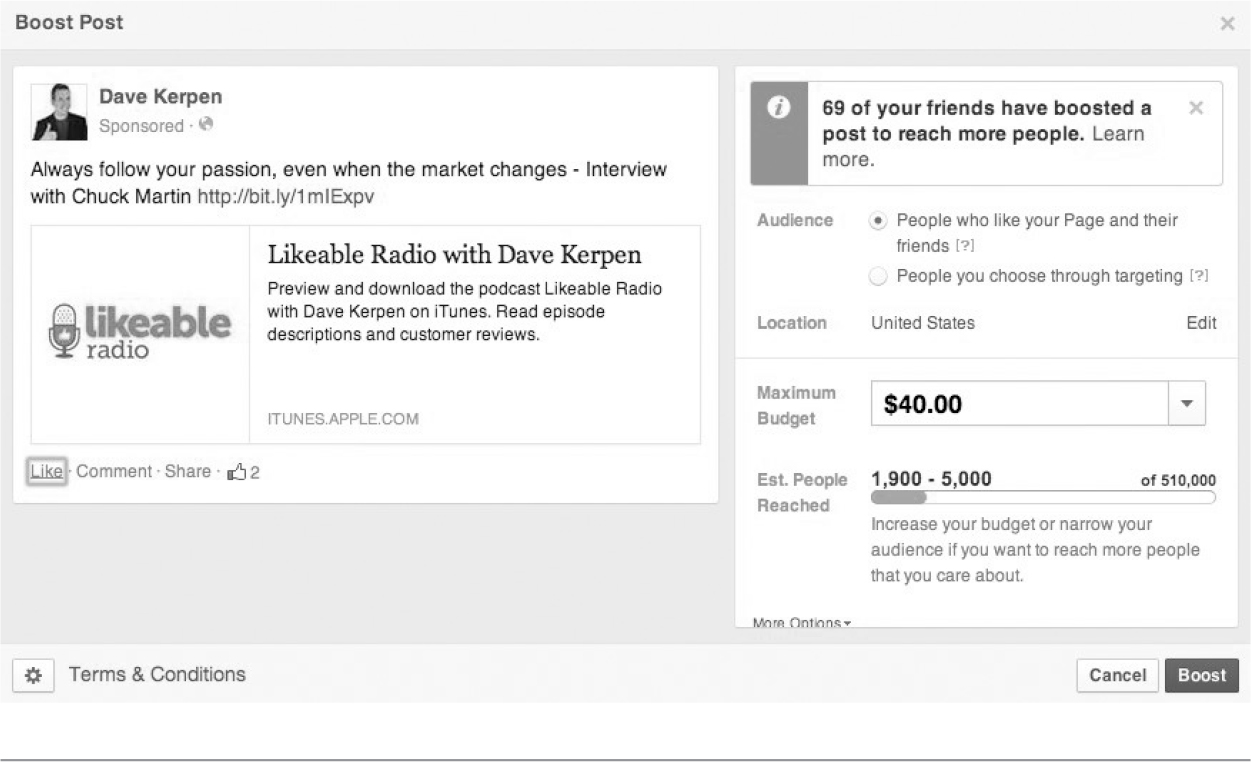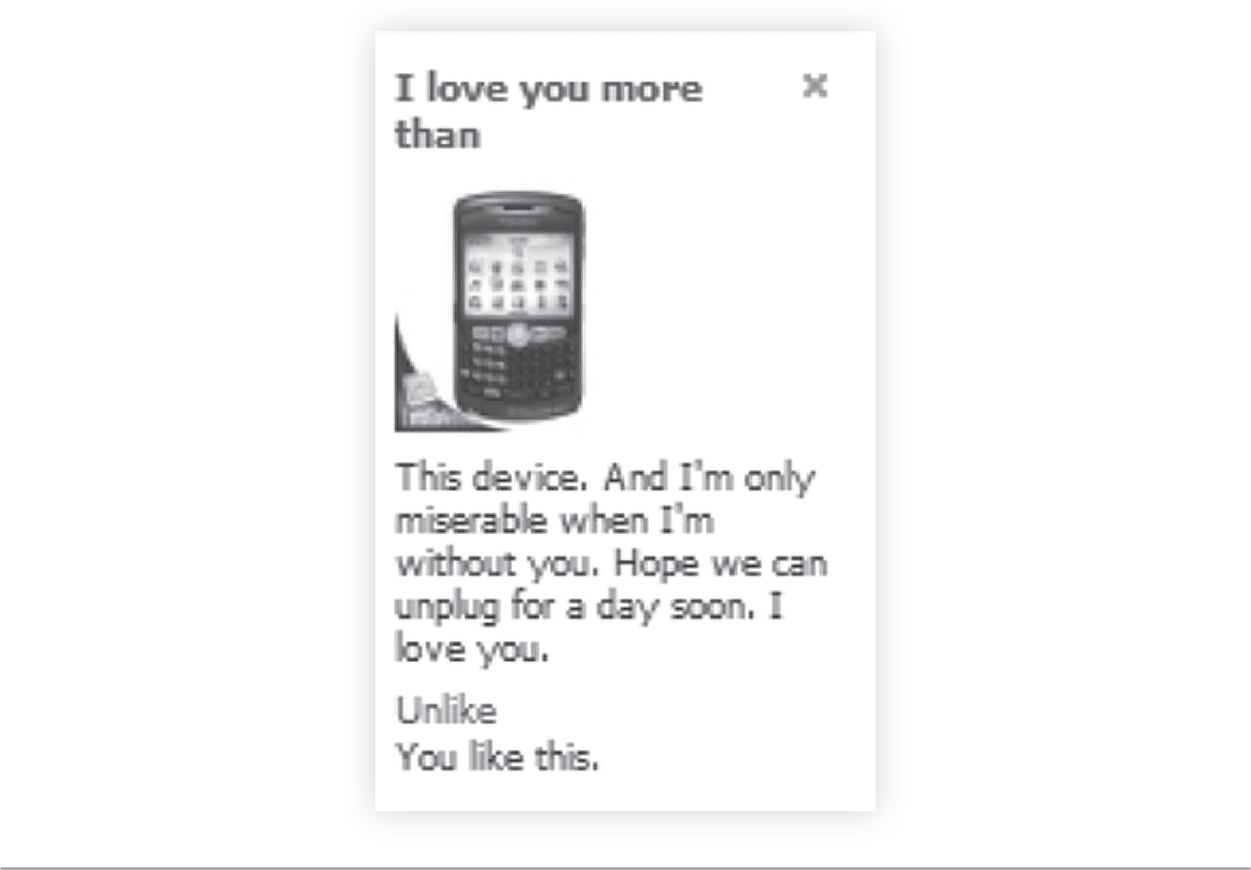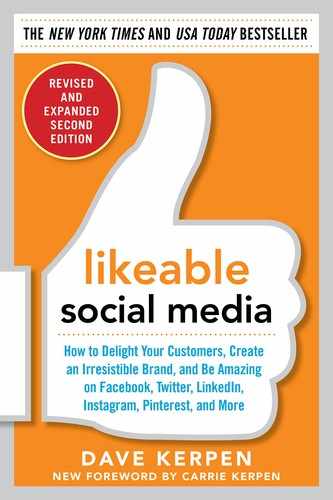
CHAPTER 15
Use Social Network Ads for Greater Impact
You’re relaxing one night at home after work, on the couch, watching some television. Your favorite show cuts to a commercial, and you’re about to hit Fast Forward on your DVR to skip the downtime, as you usually do, when you notice something strange. On the upper-right corner of your television screen, you see your friend’s name! You hold off on fast-forwarding, examine closer, and read the words, “Your friend Megan Miller likes this ad.”
“Wow,” you think. “How crazy.” You watch the ad and actually find it pretty entertaining. You’re glad you paid attention to your friend Megan’s approval and didn’t skip the commercial.
The next morning, on your way to work, you’re listening to the radio, and just before the DJ goes to the commercial break, you hear, “Three of your friends, including Megan Miller, like this next company you’ll hear an ad from.” Since three of your friends like the company, the ad must be worth paying attention to, so you decide to listen.
You arrive at work, and since you’re in charge of scanning the local newspaper for articles of importance to your company, you open up the first page and begin reading. You can’t help but notice an advertisement on page 3, because right underneath this ad is printed: “Five of your friends, including Megan Miller, like this company.”
None of these advertising examples are possible through traditional, linear media, of course. In fact, they probably seem downright absurd. But can you imagine how incredible it would be if they were possible? The ability to build word-of-mouth endorsements from your friends into personalized advertising units is more powerful than any form of linear advertising ever created, and it’s currently possible using Facebook’s ad unit.
Because social ads relate people to their own friends and to other real people, they’re inherently more powerful than nonsocial ads. In the past, advertisements were about product features and benefits. Today, the content of a social network advertisement can be personalized to have the greatest impact on each user. What copy do you think would have a greater effect: “Our widgets are the best because they’re the fastest” or “Your friends Johnny and Susie like our widgets”?
FACEBOOK ADVERTISING
![]()
Furthermore, the targeting criteria that are available to marketers through Facebook are so much greater than any previous model that you can literally eliminate all waste. Remember, Facebook has lots of data, shared by hundreds of millions of users, so you can target exactly the people you want to reach.
The Amazing “Friends of Connections” Ads
Once you have customers who have liked your page on Facebook, the best way to grow your fan base and to leverage the organic power of word-of-mouth is to use Facebook ads that target Friends of Connections among your targeting criteria. (See Figure 15.1.) Done right, you essentially use these ads to market your company through your existing customers’ and fans’ connections and likes, gaining their friends’ attention instead of simply marketing to a mass audience or an untargeted group of people.
FIGURE 15.1 Friends of Connections Ad

The average person on Facebook has 350 friends. So even if you just have 100 people who like your page to begin with, an ad seen only by friends of connections has a target audience of roughly 35,000 people. If you have 1,000 fans, that’s an average target audience of 350,000 people. The numbers can be astounding, but much more compelling is the fact that every ad served is personalized to tell your prospects which of his or her friends already like you inside the ad itself. You cannot receive a better endorsement!
Three Important Types of Ads
In the past few years, Facebook has extended Friends of Connections targeting to its different types of ads. Gone are the days of solely advertising to drive page likes. Unlike other advertising media, Facebook allows you to target your precise demographic with the exact call to action to fit the campaign needs. From driving users to download your app to boosting engagement on your content, Facebook allows you to seamlessly advertise on mobile and desktop. Though there are more than a dozen different types of ads, these are three of my favorites:
1. Driving traffic and leads. Driving website traffic is the most common use of Facebook advertising. Oftentimes companies use these to drive customers to specific landing pages such as a blog or a “Buy Now” page. In the past, domain ads (which appeared on the right-hand side of your Facebook News Feed) were extremely popular. Nowadays, ads using images and videos in the News Feed are much more successful. Take, for example, the block of ads from my News Feed shown in Figure 15.2. The Huffington Post ad with a picture of a wedding (and my friend Tessa’s recommendation) is way more powerful than Poland Spring’s sidebar ad. When you’re marketing, remember to think like a consumer. Ask yourself, “Would this catch my attention? Would I click on that link or like this page?”
2. Post likes and engagement. Post boosts have become increasingly important since early 2014. As Facebook’s News Feed algorithm continues to evolve and Facebook works to bring in more ad revenue, it’s become much more difficult to get your business page’s content viewed organically. In fact, fewer than 10 percent of your fans on Facebook will see your posts if they’re not boosted. This has huge implications for businesses, both big and small. You’ve worked hard to build your audience, and it would be a shame for them to miss out on your posts. Facebook allows you to boost content right from the post. With just a few clicks, you can have your Facebook post in front of thousands of your fans—and their friends. Figure 15.3 is an ad for the Likeable Radio podcast that reached thousands of people for just $40.
3. App installation ads. App installation ads have become increasingly more important for brands with mobile apps. Americans alone download millions of apps every day. In fact, Apple recently reported a total of 75 billion app downloads in June 2014 alone. App installation ads allow for users to download applications directly from Facebook on mobile phones. Through call-to-action buttons, users are redirected to the app store to complete the download.
FIGURE 15.2 Which Ad Is More Powerful?

FIGURE 15.3 A Post Boost

Choosing Targeting Criteria
It’s great targeting friends of existing likers, and chances are many of your customers’ friends have a lot in common with your customers. But remember, you can choose exactly what targeting criteria you want to apply to each ad you take out on Facebook. Not all of these will necessarily apply to you, but they’re all worth a look. Here’s a review of each:
• Location. Target people by country, state, city, or town. For local businesses, you can target people in your town, or within a 10-, 25-, or 50-mile radius.
• Demographics. This is where you input age, gender, and even ethnic affinity. Ideally, you have an understanding of who your customers are, so that you can target specifically here, as in 23- to 25-year-old Caucasian women, or 56- to 65-year-old Asian men.
• Interest and behaviors. Arguably the most important category of ad targeting, this is where you can identify people by their interests. With data on over 1 billion people, Facebook allows marketers to target by interests, both explicit and intrinsic. Explicit interests include things like cooking, biking, running, jazz, going to church, or reading fiction. Intrinsic interests are behaviors Facebook gleans from the users’ activities and profiles. Behaviors include purchase and search history as well as likes. There are nearly 1 million possible likes and interests to choose from! You can also target by job titles, which is incredibly valuable in the business-to-business space. Reach only CEOs, marketing directors, purchasing managers, or real estate agents, for instance.
• Birthday. Self-explanatory. It’s nice to wish people “happy birthday” on a day they almost always log in to Facebook.
• Relationship status and interested in. Target just singles, married people, people in relationships, or engaged people here. You can also target men interested in women or women interested in men. For obvious reasons, this category is particularly valuable to companies in the wedding industry or dating industry.
• Language. Target people who are using Facebook in a specific language. There are more than 200 different languages spoken on Facebook.
• Education and work. Target people by their education status or their company. Again, in the business-to-business space, this is particularly valuable. Perhaps you want to reach people at five specific companies in your town or land a new client from one particular company or industry. Maybe you want to get someone’s attention to land a new job.
The more specific your target audience, the better. Personalized ads based on these criteria will go so much further in promoting your organization than any traditional mass-media outlet. Use your current fans to create ads that apply to their friends and will therefore attract new customers.
Custom and Lookalike Audiences
Another capability of Facebook ad targeting is creating custom audiences. With the ability to upload e-mail lists or import data from your website’s conversion pixels, companies can target more precisely. Say, for example you’re an e-commerce brand looking to advertise to women who have purchased from you in the past six months. Using custom audience targeting, reaching those women is easier than ever.
Lookalike Audiences let companies advertise to people who resemble current fans or people who would be interested in your business. All you need is a custom audience list for Facebook to match with other users with similar interests, behaviors, or demographics. For example, if Dr. Ken Redcross (from Chapter 4) wanted to target people who “look like” his current patient base, he just needs to upload his patient’s e-mail list.
Seven Cool Things You Can Do with Facebook Ads
Just to get you thinking about all of the potential that’s out there, consider these seven possibilities for using Facebook ads:
1. Target people on their birthdays! Reach your customers or prospects on their birthday, while they’re checking out all of their friends’ birthday wishes on their wall. You can offer them a discount or a special prize or simply surprise them by saying “Happy birthday” from your company.
2. Target your fans with reminders about cool events and promotions, or just to say thank you. Once you generate likers, you can talk to them for free through the information stream on Facebook. But if you have a particular message or offer you want to reinforce to people who you know already like you, this is a great, inexpensive way to guarantee that message will be seen.
3. Target your employees! Has it been a tough week? Congratulate them for getting through it, or thank them for their hard work! You can do this using the Companies targeting feature, or use job titles combined with companies to target individual departments at your company.
4. Introduce yourself to a new company. Just landed a job as a social media specialist at a new firm? Show the company just how cool and social media nerdy you are by introducing yourself to your new coworkers in an ad.
5. Target your significant other. You already know everything about this audience. Just input all of the criteria, and you’ll get an ad built exclusively for him or her, literally advertising your love. Take a look at the example in Figure 15.4. (I can’t believe I was ever in love with a BlackBerry!)
6. Build potential relationships with key partners. Target people with “CEO” or “president” and other similar job titles in their profiles at the companies you’re interested in building relationships with.
7. Target specific job titles. Get connected with the exact employees you want to reach. If you’re a marketing software company, then targeting the CMO or marketing director will be more beneficial than targeting everyone at said company.
FIGURE 15.4 Targeted Love Ad

All seven of these practices will help you further build relationships with your customers, prospects, coworkers, employees, and partners online and offline, but these are just a start. What other ways could you target your specific audience through Facebook ads?
Make the Ad Likeable
Once you’ve selected all of the targeting criteria, you get to actually create the ad, using a headline, a few lines of copy, and a picture. The picture is by far the most important element of a Facebook ad, so you’ll want to select a bright, size-optimized image that gets people’s attention. You can run an unlimited number of ads under the same budget, so you’ll have the opportunity to test out dozens or more of different images, headlines, and copy to see what’s most effective in driving likes.
You’ll need to set a daily budget, which can be as low as $5 and as high as you’d like. You can buy ads through CPM (cost per thousand impressions), CPC (cost per click), or CPA (cost per action). With CPM, your ad may appear many thousands of times, but if nobody clicks on the ad, you’ll have nothing to show for your money. With CPC or CPA, you pay only when people click on your ads or take your desired action—so you’re only paying for results. CPC or CPA is recommended in order to guarantee how many actions you’ll get for your money.
Keep Your Social Ads Social
A lot of companies have failed at using Facebook ads to drive direct sales because people spend time on Facebook to socialize and connect with others, not to buy stuff. The formula for ad success is not just to link ads to your website or shopping cart but to link to your fan page. Connecting users to your page encourages them to engage with you. They might enter a contest or ask you some questions about products, services, or your industry. They have the opportunity to connect with other people in your community. Remember Chapter 5: the object is to engage with your customers or prospects. You’ll have ample time to make a great impression on them later—you’ve just got to get them to like you first.
ADVERTISING IN OTHER SOCIAL NETWORKS
![]()
Facebook advertisements are the most used and most effective form of social network ads, but they are not the only kind. Both LinkedIn and Twitter, for example, provide direct advertising opportunities as well, with the abilities to target specific audiences and help companies continue to build their online social Web and presence.
Use LinkedIn Ads to Reach Professionals
LinkedIn hosts more than 300 million user profiles, and the users are often more business focused than Facebook’s users. Users can either drive traffic to a website or to another page on LinkedIn. While not quite as specific as Facebook’s criteria, LinkedIn offers great targeting criteria to reach professionals, including industry, job title, seniority, age, gender, location, skills, and group affiliation. It also offers CPC and CPM models, and it allows for ad budgets as small as $10. LinkedIn ads are often more expensive than Facebook ads on a per-click basis, but then again, you’re reaching senior professionals. How valuable is that to your business?
The coolest social aspect of LinkedIn ads is that underneath each ad is a link to the profile of the person who took out the ad. It’s not as strong an endorsement as a Facebook Friends of Connections ad, but it’s a compelling feature. This transparency and subtle invitation to connect is refreshing. Instead of an advertisement coming from a giant faceless organization, it’s literally shown as coming from one individual, who’s on LinkedIn, just like the person who is viewing the ad. Can you imagine if every ad you saw on television or read in a newspaper had the personal information of the person who took out the ad? That would lead to greater transparency and accountability and likely to better ads being made.
Twitter Ads Allow You to Join the Stream
Twitter has tinkered with a number of different advertising models, but at the moment, Promoted Tweets, Promoted Trends, and Promoted Twitter Accounts all allow advertisers to get their company’s most recent tweets in front of people who are using particular keywords on Twitter. Similar to Facebook, Twitter has also increased its objective-based campaigns. This process is most similar to Google’s AdWords model, wherein people who search on Google using specific keywords find sponsored listings from advertisers who have preselected (and bought) those keywords. With Twitter, though, it’s more about the conversation than the search. For instance, try searching on Twitter for doctors in Brooklyn to see what people are saying about their doctors in that area. If a doctor in Brooklyn has purchased specific keywords (such as “Brooklyn,” “doctor,” “patient,” or “care”), her last tweet will show up at the top of your stream.
Twitter ads are particularly useful for driving traffic to your website, driving app installs for your mobile app, and driving lead generation through e-mail list ads.
THE LIFETIME VALUE OF A SOCIAL NETWORK AD
![]()
Advertisements have traditionally sought to raise awareness, to increase purchase intent, and to convert passive recipients into customers. At the end of a linear ad, the recipient has become more aware and has decided whether to purchase something or not. Where social network ads differ and can actually be much more valuable, however, is in starting the conversation. All that an ad on Facebook or Twitter really needs to do is generate a like or a follower, respectively, for your company. After that point, you have the ability to talk to (and engage with, and eventually sell to!) those fans or followers for the rest of their lives, without any additional advertising expense.
Of course, if you become too marketing or sales heavy in your social network messaging, people can and will “unlike” you or “unfollow” you. To a great extent, that situation has happened with e-mail marketing: e-mail mailing lists aren’t usually used to engage or provide value. They’re used to sell—and consequently, people who were once fans of a company, often grow to be annoyed by, or even hate, that same company, and eventually they unsubscribe from their e-mail lists.
You have an amazing opportunity to target your ideal customer, and for the price of one click (this can range from $0.50 to $3.00, depending on your targeting criteria), you convert someone to like you or follow you and join the conversation. Once he’s in your community, you can have his attention literally for the rest of his life, as long as you engage appropriately. What is the lifetime value, then, of that initial ad, like, follow, or click?
Likeable’s Ads Stumble but Then Build a Business or Two
At Likeable Media and Likeable Local, we’ve purchased Facebook ads for thousands of clients, and we’ve used the targeting criteria and Friends of Connections opportunities to grow many communities. But the number one example I’d like to share of how to use Facebook ads comes from our own firm’s experience. Facebook ads are the only form of paid advertising we’ve used, resulting in the growth of a company from literally nothing into $15 million of revenue in seven years. We didn’t target correctly at first, but we learned our lesson. And we only spent about $30 per day to do it.
Here’s what we did first: we targeted keywords in the Interests category, such as “marketing,” “promotions,” and “social media.” While this generated a lot of fans who were interested in these areas, they may not have been our actual prospects because they likely included students and other people who were interested in these topics but had no decision-making authority at companies. So we shifted gears.
We knew that the decision to hire a marketing agency is made by multiple people at a company, and we could reasonably identify most of them by job title. So we consistently created ads targeting these people: chief marketing officers, vice presidents of marketing, marketing directors, and brand managers. We didn’t ask people to call us or even check out our website in ads. Instead, we asked them only to connect to our page on Facebook and join our community. Then, every day, we shared the best content we could find, and we wrote about social media and provided advice about how to best leverage it. The ultimate pull-marketing model eventually worked, and today, dozens of these people have called or e-mailed us asking for our help. Out of the 50,000 fans in our two Facebook communities, more will certainly reach out. But they’ll reach out when they’re ready to buy, not when we’re ready to sell.
Soap.com Uses Facebook Ads to Drive Online Sales
Soap.com is a major online retailer that delivers everyday essentials to people’s homes. From shampoo and conditioner to diapers and detergent, Soap.com takes the “dirty work” out of shopping for everyday household items.
In early 2014, Soap.com was looking to acquire new customers, and it experimented with page post link ads. Using the ad shown in Figure 15.5, Soap.com targeted people who had never been to its website before, and it tested different types of creative ad copy. Some of the best-performing ad sets targeted “big city moms” and “beauty product purchasers.” Every “big city mom” who saw the ad also saw a call-to-action button encouraging her to “Shop now” or “Learn more.” In just four months, Soap.com drove more than $100,000 in sales from Facebook ads. The entire campaign cost less than $10,000—talk about ROI! I think we’d all take a 10-to-1 return on our investment for just about anything!
FIGURE 15.5 Soap.com’s Facebook Ad Targeting People Who Had Never Been to Its Website

Pure Barre’s Sticky Socks Stick
Pure Barre is a fitness company that uses a unique technique to transform bodies. Using aspects of ballet, pilates, and weights, the Pure Barre experience is said to be the “fastest, most effective way to change your body.” With more than 170,000 fans on Facebook, Pure Barre decided to focus its ads on driving merchandise sales—namely, its “sticky socks.”
Pure Barre started by targeting its existing fan base with page link posts to drive fans to their sticky socks landing page. After some trial and error, Pure Barre decided to target the socks to fans who had indicated purchasing behavior—that is, people who had purchased from the website in the past or who had viewed the Shop Now landing page in past weeks (Figure 15.6). The sticky socks sell for $12, and Pure Barre’s CPA was $0.50. Once the company nailed down the precise target demographic, selling the socks was effortless and scalable.
FIGURE 15.6 Pure Barre’s Facebook Ad Targeting People Who Had Visited and/or Purchased from Its Website

CREATE LIKEABLE SOCIAL ADS
![]()
In a world dominated today by disruptive and unwanted advertising in so many forms, social media ads allow you to be more likeable, literally and figuratively. These ads give you the ability to find and connect to your perfect target audience and to leverage built-in word-of-mouth endorsements. Instead of creating transaction opportunities, these ads establish lifetime connections with potential customers—and their friends. In a challenging economy, when it’s worth considering cutting back on your traditional advertisements (which may or may not be effective), it’s time to look closely at social media ads to boost your fan base and generate new customers.
